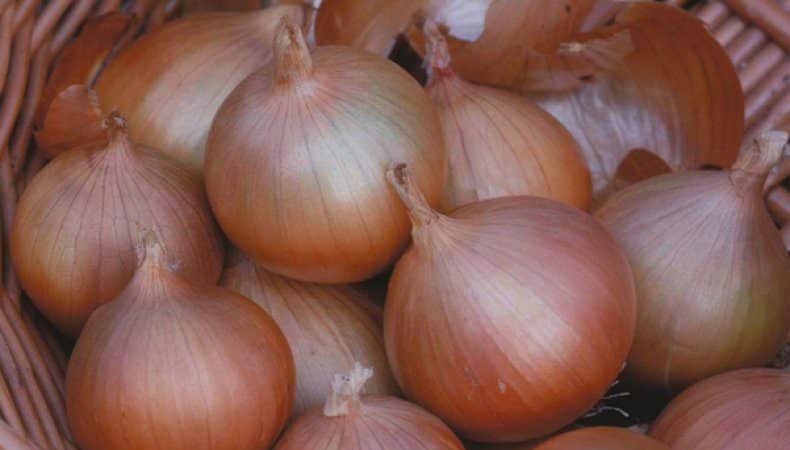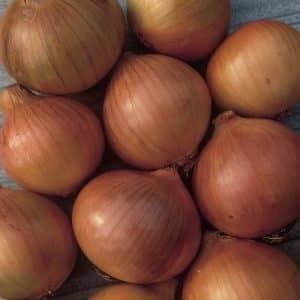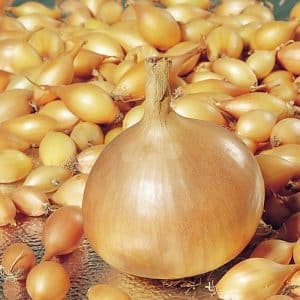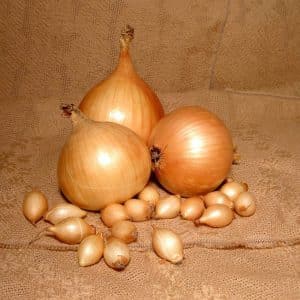Cold-resistant onion variety “Setton” for long-term storage
Why is the Setton onion popular among many gardeners in the northern latitudes of Russia? From the article you will learn details about the Setton onion variety: its appearance, taste, characteristics of planting and cultivation, as well as reviews from experienced farmers.
Description of the variety
Let us consider in detail how the Setton variety differs from others.
Origin and development
Look Setton appeared in the Netherlands specifically for growing in the northern part of Europe. It is precisely for its resistance to low temperatures that Russian gardeners and farmers fell in love with it. Growing Setton onions does not cause difficulties in our northern regions.
Chemical composition and beneficial properties

Onions are rich in B vitamins, as well as C, E, H, K, PP, and beta-carotene (provitamin A).
The vegetable contains the most carbohydrates (8.2 g per 100 g of product) and dietary fiber (3 g per 100 g of product).
Onions are rich in macroelements such as potassium, sulfur, calcium, chlorine and magnesium. It also contains:
- essential amino acids (arginine, valine, histidine);
- nonessential amino acids (alanine, glycine, tyrosine);
- omega-3 and omega-6.
Ripening period
Late ripening, ripens in August.
Productivity
It is characterized by increased productivity, which is why gardeners love it so much. The yield is 6 kg per square meter. m. Ripening before harvesting itself is 96%, in comparison with other varieties this is an increased figure.
Disease resistance
Setton, like other representatives of onions, is not immune from diseases. The risk of disease will be significantly reduced by preventive measures. It is recommended to treat the feather with a solution based on copper sulfate when it reaches a height of 15 cm. This will ensure resistance to fungus.
It is also necessary to treat the seedlings before planting. The seed material is soaked either in a special solution (“Quadris”), or proven folk remedies are used (saline solution, then a solution of potassium permanganate). By preparing the material in this way, you will protect it from most diseases and pests - such as downy mildew, neck rot, nematodes, and onion flies.
Characteristics of the bulb

Dense golden bulbs grow up to 120 g. Their rounded shape tapers towards the tail. "Turnips" is excellent are stored. The surface of the onion is covered with dry brown scales. Inside contains white pulp with a pleasant, mild taste.
The feather reaches a height of 30 cm. The bulbs weigh 150-170 g.
The vegetable can be consumed fresh and for processing.
Climate requirements
The Dutch variety is resistant to cold weather. The bulbs feel great at a temperature of -15°C, provided there is no snow cover.
Since the variety is unpretentious, it is grown in both the southern and northern regions.
The main advantages and disadvantages of the variety
The only drawback is the high price of seed. But if you grow onions yourself, you can easily get the seeds and germinate the sets yourself.
Advantages of the variety:
- frost resistance;
- does not form many arrows;
- unpretentious to the soil;
- synchronous ripening of all seed material;
- high germination and productivity;
- well stored (sets and turnips themselves);
- has a pleasant, moderately spicy taste.
Features of planting and growing
The Setton variety is unpretentious in care.But there are nuances, knowing which you will get a much larger harvest, untouched diseases and pests.
Preparing for landing
Regardless of the landing, preparations begin in the fall.
The place must meet the following requirements:
- be open and well warmed by the sun;
- not flooded by groundwater;
- the soil should be loose for oxygen saturation and better water retention.
Sevok is either purchased or grown independently. Before planting, dry and warm at a temperature of 20°C.
Reference. Some gardeners warm up the bulbs the day before sowing by immersing them in hot water for 15-20 minutes. This is not necessary, as there is a risk of accidentally cooking the delicate seed.
The seeds are soaked for three hours in a saline solution to stimulate physiological processes. Then they are immersed in a solution of potassium permanganate for two hours, thereby disinfecting the seed.
Soil requirements
Loams with a neutral or slightly acidic pH are suitable for this variety.
The soil is dug up and organic fertilizer is applied (3 kg per sq. m).
You can’t do without fertilizing. For 1 sq. add the following ingredients one tablespoon at a time:
- nitroammofoska - complex fertilizer to increase productivity;
- superphosphate - to increase soil fertility;
- wood ash - to improve the mechanical and chemical composition.
Dates, scheme and rules of planting
There are two planting methods: winter and spring. Favorite among gardeners - winter - provides better yields compared to the classical method.
October-November is suitable for winter sowing, when the temperature stays within +5°C for several days. The harvest is early. Use bulbs with a diameter of 1 cm.
There are some nuances when planting in spring:
- planted as soon as the snow melts;
- cover material is used (with the appearance of greenery, remove it);
- A layer of straw, hay, and sawdust is poured on top of the planted seedlings;
- sowing time - in April or early May;
- use bulbs with a diameter of up to 2 cm.
Onion sets are planted at a distance of 10 cm from each other, and there should be a space of 30 cm between the rows. The sowing depth should be from 4 to 6 cm from the neck. Sprinkle a layer of earth (3 cm) on top and water.
Features of cultivation
Experienced gardeners advise making two beds side by side and growing onions on one and carrots on the other. The two cultures will protect each other.
Important. Grow carrots and onions in two separate beds, as they require different watering regimes.
The area of the plot does not always allow for correct crop rotation - growing onions every year in a new place. This problem will be solved by planting between the rows of onions - phacelia, which grows up to 10 cm. Such soil filling will enrich the soil with mineral and organic substances, and also disinfect it.
Nuances of cultivation
The best planting option for Setton is high ridges.
Attention. Weed and loosen the soil in a timely manner, do not forget about watering, as onions love water. But don't overdo it; too much moisture will cause the onions to rot.
Watering mode
Water according to the weather. Excludes excess moisture at the roots. Maximum watering is during the growth period of greenery and turnips.
Irrigation scheme:
- once every 10 days in case of rain;
- once every 5 days during hot weather;
- Stop watering 3 weeks before harvest.
Loosening the soil and weeding
Regularly loosen the soil between rows, before and after watering. Weed so that weeds do not choke out the cultivated plant.
Top dressing
The most popular scheme among summer residents is:
- first fertilizing - with organic fertilizers (urea, saltpeter), two weeks after planting;
- second — mineral fertilizers (nitroammofoska), three weeks after the first feeding;
- third - calcium-based fertilizers, three weeks after the previous application.
Disease and pest control
In order for onions to feel good, experienced gardeners advise planting them next to carrots. They also follow these rules:
- Prophylaxis against fungus, in particular downy mildew, is carried out. When the height of the feather reaches 15 cm, spray the leaf with a solution of copper sulfate (1 tsp per 10 liters of water).
- If yellow spots appear on the feather, this is a sign of the development of fusarium (bottom rot). Fungicides are required for treatment.
- Drying onions for 10-12 days at a temperature of 25°C will save you from neck rot.
- Prevention before planting will help against stem nematode - water the soil with a salt solution (3 tablespoons per 10 liters of water).
- A tobacco solution will repel onion flies: 200 g of tobacco dust is poured into 3 liters of hot water and left for two days. Then add a tablespoon of liquid soap and 1 tsp. ground red pepper and bring the solution to a volume of 10 liters. Before spraying the soil and plants, filter the solution.
Harvest and storage

The harvest is harvested in dry weather, when brown scales have already formed on the “turnip” and the feathers sink to the ground. The onions along with the tops are laid out in a dry place (in the attic) to dry. Then the pen trimmed, leaving the tip up to 4 cm, and again left alone until completely dry.
Store in basements, cellars, utility rooms that are sufficiently dry and have ventilation, at temperatures from 0 to 22°C and humidity up to 80%.
If all conditions are met, the shelf life of the variety reaches 7 months.
What difficulties may there be when growing
If there is a lack of moisture, the onion will give a bright signal - the feather will either turn gray or turn white. If there is an excess of watering, the above-ground part will also report this - the feather will become faded in color.
If there is a lack of nitrogen fertilizers, growth will slow down.
If the onion dried out ahead of time, it did not have enough phosphorus, and if the feather turned gray, it did not have enough potassium.
Advice from experienced gardeners
Onions will grow better if crops grew before them at the planting site:
- tomatoes;
- cucumbers;
- cabbage;
- beans.
In the spring, before planting, water the soil with a solution of copper sulfate - 1 tbsp. l. per 10 liters of water and cover the bed with film for two days.
Reviews about the Setton onion variety
Numerous positive reviews about the Dutch variety confirm its frost resistance and other advantages:
Vladimir, Tver: «Very pleasant taste, not bitter. I grow it every year and have never regretted it. My setton does not get sick or rot, because before planting I am looking for a new place for it. In the onion bed, I plant wild pink clover, it enriches the soil with nitrogen. And next year - the soil is prepared for growing onions. The harvest is always great."
Natalya, Petrozavodsk: “I live in Karelia, where the climatic conditions are, to put it mildly, harsh. I always select frost-resistant crops for my garden. Setton onion is great, I recommend it. You don't need to bother with it. It is enough to treat the seedlings before planting and fertilize the soil. I rarely water because it rains constantly.”
Conclusion
Setton onion sets and seeds will allow you to independently grow one of the most productive varieties without much effort. Thanks to its resistance to cold, long storage and unpretentiousness, the variety is popular in all regions of Russia.This vegetable is suitable for preparing salads and dishes in fresh and processed form, and is used in canning.